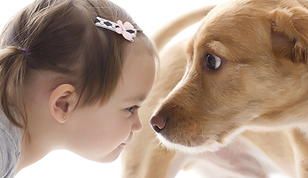Blog Categories
Search Blog
Blog Categories
Utilizing your Dog in Pediatric Therapy
What are animal-assisted therapy animals?
“These animals are specifically trained to support the efforts of physical rehabilitation and occupational therapists to meet the needs of a person’s recovery program. The animals encourage patients to work on fine motor skills, range of motion, balance, interactive skills.”
Even though your family dog was not trained as an animal-assisted therapy dog to work in a facility such as a school, hospital or clinic, there are ways for you to utilize your dog in your child’s rehabilitation at home.
Benefits of using your dog in therapy:
- Increase alertness and attention span to complete tasks (especially with children who have learning disorders)
- Provide motivation for your child to complete physical, occupational or speech therapy exercises
- Reduces the stress of the environment or frustration caused if the child has a learning disability
- Increases the ability for the child to learn how to multi-task and perform multi-step sequences successfully
- Promotes relaxation and calmness via release of beta-endorphins
- Decrease in blood pressure and cortisol levels
- Increase in oxytocin levels causing a decrease in isolation and loneliness
- Pain reduction via release of endorphins
How can I incorporate my dog into my child’s therapy at home?
In order for your child to comply with his/her therapy it is important for them to enjoy it. The best way for them to enjoy it, is for them not to know they are actually having therapy…make it FUN!
One method of doing this is to incorporate your dog into your child’s home therapy program (whether it’s physiotherapy, occupational therapy or speech therapy). You will need to be creative in your thinking, think outside the box. Here are some ideas to help you. These are specific to a home-based physiotherapy program.
- If your child is working on strengthening his/her upper extremity have him/her reach out towards the dog with a treat. You can instruct your child to reach in different directions (up, down, right, left, across midline, etc.) in order to strengthen different muscles around the shoulder joint.
- If your child is working on gait (walking), have him/her walk across the room to bring a toy/treat to the dog. Repeat over and over and make a game of it!
- If your child is working on crawling skills, motivate him/her to crawl towards the dog and pet him/her.
- If your child is working on strengthening their handgrip or forearm muscle tone, have them brush the dog.
- If your child is working on their endurance (walking/running), have them chase the dog in the backyard, or have the dog chase them. Have your child take the dog for along walk to the park.
- If your therapist recommended hydrotherapy (swimming) as a form of exercise for your child and you have a pool at home, have your child swim with your dog. Of course your dog needs to enjoy swimming too!
- If you are working on your child’s balance, give the dog a toy and have your child play tug-of-war.






